
Welcome | History | Student Life | Academics | Reflections | Contact Us

Welcome | History | Student Life | Academics | Reflections | Contact Us
Delta State has witnessed a variety of changes since President Kethley and campus 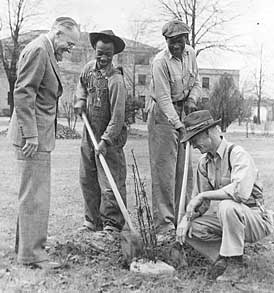 gardeners planted a tulip tree in celebration of his birthday. Below are sections that provide a glimpse into the past involving events of interest, significant moments in our history, and university leadership.
gardeners planted a tulip tree in celebration of his birthday. Below are sections that provide a glimpse into the past involving events of interest, significant moments in our history, and university leadership.
The campaign to locate Delta State in Cleveland began several years before the  doors opened for the first summer session in 1925. There is evidence that the subject was brought up for discussion as early as 1910 at a meeting of the Cleveland Business Men’s League. Senator Roberts would eventually take the idea all the way to the State House floor. Ultimately, the efforts of many people would lead to the start of a new institution. The humble beginnings of three buildings that were once the original Agricultural High School has grown to the bustling campus of today.
doors opened for the first summer session in 1925. There is evidence that the subject was brought up for discussion as early as 1910 at a meeting of the Cleveland Business Men’s League. Senator Roberts would eventually take the idea all the way to the State House floor. Ultimately, the efforts of many people would lead to the start of a new institution. The humble beginnings of three buildings that were once the original Agricultural High School has grown to the bustling campus of today.
In 1928, the first graduating class consisted 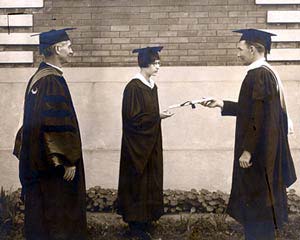 of thirteen students. A tradition was established that the first degree was to be awarded on the basis of scholarship. Miss Mollie Bedwell of Cleveland, MS holds the distinction of receiving the first degree ever granted by Delta State Teachers College. The original 1925 staff of the institution consisted of a president, business manager, dietitian, and nine teachers.
of thirteen students. A tradition was established that the first degree was to be awarded on the basis of scholarship. Miss Mollie Bedwell of Cleveland, MS holds the distinction of receiving the first degree ever granted by Delta State Teachers College. The original 1925 staff of the institution consisted of a president, business manager, dietitian, and nine teachers.
Life in the Mississippi Delta offers a variety of experiences. However, as you  might imagine, its southern climate doesn’t allow for much snow. A simple snow fall on campus would provide its own special brand of entertainment.
might imagine, its southern climate doesn’t allow for much snow. A simple snow fall on campus would provide its own special brand of entertainment.
Delta State Teachers College would offer a number of workshops during the summer sessions to increase the awareness of physical education. They would range from aquatics to dance and were available to teachers, administrators, and supervisors. Margaret Holmes, a student from 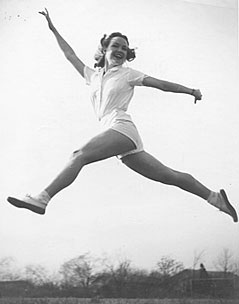 McComb, MS, aptly demonstrates her skills in a modern dance group.
McComb, MS, aptly demonstrates her skills in a modern dance group.
The railroad line between Memphis and New Orleans is completed, running through Cleveland, then known as Fontaine. The town is also known as Coleman.
The town of Cleveland is incorporated.
Cleveland becomes the second county seat (in addition to Rosedale).
Mississippi Legislature passes the Agricultural High School Law.
World War I breaks out in Europe.
United States enters the war.
World War I ends with an armistice signed November 11, 1918.
A flu epidemic sweeps through Europe and the United States killing 9,234 Mississippians.
Cleveland’s population is 1,674.
First formal talk of establishing a state institution of higher learning in Cleveland. Cotton is selling at 22.5 cents a pound.
Group of Cleveland citizens offer the closed Bolivar County Agricultural High School’s buildings to the state for a teachers’ college.
February 19, Senator W.B. Roberts and Senator Arthur Marshall introduce Senate Bill 236 which creates Delta State Teachers College and is signed by Governor Whitfield on April 9.
February 14, James Wesley Broom is appointed first president. June 7, Delta State Teachers College opens its doors for summer school in its first session. September 15, a formal opening of the college with a faculty of eleven, fall quarter enrollment of 97, winter quarter enrollment of 91 and 98 students enrolled for the spring quarter. Although athletics would debut the next year, it was determined that the mascot would be “Green and Whites”.
May 17, after just fourteen months as president, Jim Broom dies in Memphis. July 15, William Marion Kethley is appointed the second president. Hill Demonstration School for grades one through six opens under Laurie Doolittle in Hardee Hall as a laboratory school for those students studying elementary education. YWCA organized Girls’ basketball team became known as the “Rabbits Foot Squad” October, the first issue of the Miss Delta, a bi-weekly campus newspaper is published.
Cleveland Hall, a new women’s dormitory, is opened. It is the first new building built for the campus. President’s home and College Dean’s home are completed. The Mississippi River breaks through the levee at Scott. It causes the loss of $40,000,000 worth of property, displaces 185,495 people, and floods 41,673 homes.
First yearbook, The Broom, is issued. May, first graduation exercises are held and Mary (Mollie) Bedwell, class valedictorian, receives the first diploma. Thirteen women receive the Bachelor of Science in Education.
Broom Memorial Administration Building, Scott Dining Hall, and Ward Hall are completed.
In a political move, Governor Bilbo removes from office all the college presidents under the control of the State Board of Trustees except President Kethley. Delta State is the only college that has a different board than the other Mississippi universities. When the Board of Trustees of Delta State gather at its annual meeting, Bilbo’s effort to control the action of the board fails and President Kethley and the faculty are re-elected.
Delta Playhouse is organized by Miss Fugler of the English Department. Delta State is granted full membership in Southern Association of Universities and Colleges.
First group of children to complete six-year course in Demonstration School receives certificates. Fall enrollment is 382 and the faculty number 30. The Rabbit Foot Squad wins the Mississippi Valley Conference two years in a row.
Franklin Roosevelt is elected president and the New Deal begins. Enrollment peaks at 432 and then starts to decline because of the Depression. Women’s basketball is discontinued.
Freshman Prom inaugurated. First ‘Springtime Pageant” is held, a tradition that lasts until 1955. 57 students graduate, the largest class in the school’s history.
Delta Singers are organized.
1935
Campus hospital is opened on the second floor of Taylor Hall. Delta Chamber of Commerce (later Delta Council) is organized and President Kethley is the first president of the organization. In addition, the beginning of the tradition that Delta Council holds its annual meeting at Delta State.
1936
Effort by the Legislature to close Delta State because of the financial hard times is averted. Works Progress Administration (WPA) completes outdoor swimming pool and Delta Field opens.
1938 – 1939
Additional buildings constructed with WPA assistance, including Whitfield Gym and Roberts Library. The library being housed in what is now the Fielding Wright Art Building.
1940
Scribes Club is organized and sponsored by Evelyn Hammett. Boy’s basketball team finishes third at National Association of Intercollegiate Basketball tournament. Selective Service Act (the draft) is passed
1941
In anticipation of war, a civilian pilot training program is established. December, Japanese attack Pearl Harbor and the United States declares war on the Axis powers.
1942
254 associated with Delta State are members of the armed services. Nursery school opens as part of the home-economics program. 19 buildings make up campus.
1943
Delta State broadens its course offerings and receives authorization to offer both the Bachelor of Arts and Bachelor of Science degrees. Because of war rationing, an area of campus is converted into a wheat field.
1944
First public demonstration of the mechanical cotton picker near Clarksdale.
1945
Roosevelt dies and Truman becomes president. Germany surrenders and Japan yields after the United States drops atomic bombs on Hiroshima and Nagasaki. Student enrollment is 185.
1946
Nationwide, over a million GI’s enroll in college. Student enrollment at Delta State is 483. Winston Churchill coins the phrase “Iron Curtain” in reference to the division between the Soviet Union and its communist satellite countries and the West. The Cold War begins. 12 year old Kent Wyatt arrives on campus with his family as his father takes a position as instructor in the Physical Education department. Delta State resumes participation in intercollegiate sports.
1947
Enrollment swells to 596. Under-Secretary of State in Truman’s administration, Dean Acheson, delivers the address at Delta Council on campus that unveils the Marshall Plan. The plan details postwar relief for Europe. Dean Zeigel retires after serving since the college’s opening and Joe Farrar succeeds him.
1948
Truman orders an end to segregation in the armed forces and is elected president.
1949
Soviet Union detonates an atomic bomb. In an effort to extend its facilities and services to the region, Delta State begins offering extension classes in academic and professional fields.
1950
Joseph McCarthy launches anti-Communist crusade. The Korean War begins. Mississippi Vocational College, present-day Mississippi Valley State University, opens in Itta Bena.
1951
First “Student Union” in the Mill, proposed by SGA President Mills Rogers and Vice-President Hugh Ellis Walker.
1952
“Stadium Dormitory” or Hugh L.White Hall, a men’s dormitory located at Delta Field, is completed.
1953
Delta State is approved for membership in the American Association of University Women. Korean War ends.
1954
The U.S. Supreme Court rules that “separate educational facilities are inherently unequal” in Brown vs Board of Education of Topeka, KS. Many southern states, including Mississippi, refuse to desegregate the state’s educational facilities.
1955
In recognition of the expanding educational programs offered at Delta State, the name is changed to Delta State College.
1956
After thirty years as president, Dr. Kethley resigns and passes away later in the same year. September, Dr. James Milton Ewing becomes president.
1957
Hill Demonstration School closes and the new President’s home is completed.
1959
Delta State changes from the quarter system to the semester system. Margaret Wade comes to the Health and Physical Education Department as an instructor from Cleveland High.
1960
John F. Kennedy, Jr. is elected president of the United States. 900 students are enrolled and the upward trend in enrollment begins, bringing with it a need for more dormitories and classrooms.
1961
Walter Sillers Coliseum, Ziegel Fine Arts Hall, Cain-Tatum Dormitory and Caylor-Williams Dormitory are dedicated.
1962
James Meredith, the first African-American student is admitted to the University of Mississippi. Riots ensue in Oxford and 3,000 troops are deployed with 375 injured and 2 killed.
1963
Civil rights campaigns throughout the South start with a voter registration drive in Greenville, MS. Martin Luther King, Jr. leads the march on Washington. JFK is assassinated in Dallas. Delta State gains full accreditation from SACS and enrollment is 1400. Kethley Hall is opened
1964
During Freedom Summer, three civil rights workers are shot near Philadelphia, MS. Civil Rights Act passes to outlaw segregation in public accommodations and creates the Equal Employment Opportunity Commission.
1965
Delta State initiates graduate program, a Master of Education in Elementary Education, Elementary Supervision, Guidance, English, History, Math, Music, Social Studies, Business Education, Physical Education, and Science.
1966
Helen Mitchell, Sandra Morgan and Arnette Rainey make history when they enroll as Delta State’s first African American freshmen students. Bond-Carpenter Dormitory, Fugler-Hammett Dormitory, and Young-Mauldin Cafeteria opens. National Organization for Women is founded.
1967
A College Foundation is established under Boo Ferriss. Massive anti-war demonstrations occur around the nation.
1968
W.B. Roberts Library is constructed. Dr. Jack Gunn is appointed Dean of the college. Johnnie Lewis is the first African American student to graduate from Delta State. Martin Luther King, Jr. and Robert F. Kennedy are assassinated. Richard Nixon is elected president.
1969
Graduate program expands to include Master of Arts in English and History, the MBA, Master of Library Science, and the M.S. in biology and chemistry. The structure of the academic side of the college is reorganized into three schools – the School of Arts and Sciences, School of Business, and School of Education Apollo 11 lands on the moon. Nixon begins withdrawing troops from Vietnam.
1970
Court of Governors (men’s dormitory) opens. Student killed at Kent State and Jackson State.
1971
Dr. Ewing retires and Dr. Aubrey Lucas takes over as president in August. Freshmen orientation includes a barge trip on Lake Ferguson and a picnic supper on the Arkansas side of the river.
1973
Dr. Lucas reinstates women’s basketball which had been discontinued over forty years earlier. Margaret Wade, a former member of the Rabbit Foot Squad, is appointed head coach.
1974
Board approves adding the educational specialist degree, EdD, in the four areas of administration and supervision, elementary education, guidance and counseling, and physical education. Delta State College becomes Delta State University. The H.L. Nowell Student Union opens. Nixon resigns.
1975
Lady Statesmen cap off their 1974-75 season with the AIAW National Championship. Dr. Lucas resigns to take the president’s post at the University of Southern Mississippi. Class of ’56 alumnus and former assistant to Presidents Ewing and Lucas, Dr. Kent Wyatt is chosen to succeed Dr.Lucas.
1976
Lady Statesmen finish out the 1975-76 season with a repeat championship. Lady Statesmen standout Lusia Harris plays on the women’s U.S. Olympic basketball team and is the first woman to score a basket in the Olympics. Division of Continuing Education and Public Service established under Dr. Daisy Howell. Jimmy Carter elected president.
1977
Third championship for Lady Statesmen. DSU baseball team under Coach Boo Ferris places third at the NCAA Division II Word Series. Department of Music is accredited by the National Council for Schools of Music.
1978
Baseball team places second in the Division II World Series. James M. Ewing Hall opens. School of nursing opens for fall semester.
1978 – 1980
Double-digit inflation and soaring interest rates.
1980
Doctor of Education degree in Professional Studies is approved. Iran hostage crisis. Ronald Reagan is elected president.
1981
Bachelor of Fine Arts in Art is approved.
1982
Master of Science in Natural Sciences is approved. Mid-year reduction in state appropriation forces the university to eliminate services.
1984
First doctoral degree is awarded. Budget cuts continue.
1985 – 1986
Fund-raising effort begins to construct an Alumni and Foundation House.
1987
Men’s basketball team reaches the NCAA Division II Final Four.
1989
Lady Statesmen win their fourth national championship.
1990
Lady Statesmen win fifth title. School of Nursing occupies the old Cleveland Hospital after major renovations.
1991
Four thousand students are enrolled.
1993
Lady Statesmen win sixth championship.
1994 – 1995
Master of Professional Accountancy and Master of Nursing are approved. Baseball team finishes third in College World Series. Brumby-Castle Resident Hall and Holcombe-Norwood Hall (addition to Wright Art Center) are completed.
1995 – 1996
Executive M.B.A. and Master of Commercial Aviation, Master of Science in Criminal Justice are approved.
1996 – 1997
Master of Science in Community Development and Master of Social Work are approved. Bologna Performing Arts Center opens for its premier season. The University Foundation launches a $5 million campaign.
1997 – 1998
Charles W. Capps, Jr. Archives and Museum Building is dedicated. University fundraising campaign exceeds $5 million goal.
1999
Dr. Wyatt announces his retirement. Fundraising campaign reaches $10 million. Addition and renovations to W.B. Roberts Library near completion. Dr.David Potter chosen as sixth president.
2000
Delta State University celebrates its 75th anniversary. The Delta Center for Culture and Learning is launched.
Delta State’s football team wins the Division II National Championship.
2001
Construction is completed on a new 46,000 square foot aquatic center that offers state-of-the-art facilities.
2002
Dr. Potter leaves Delta State University to take a position at the Mississippi Institutions of Higher Learning.
2003
Dr. John Hilpert is inaugurated as the 7th president of Delta State.
2004
A new administration building, named in honor of Dr. Kent Wyatt, opens in the fall of 2004.
The DSU baseball team wins the 2004 Division II National Championship.
2005
Delta State contributes to the Hurricane Katrina relief effort by opening Hugh White Hall to house evacuees.
In February 1925, H. B. Heidelberg, chairman of the presidential selection 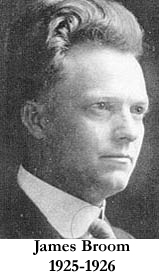 committee announced the unanimous nomination of James Wesley Broom for the college’s first president. Broom had previously served as a school principal, taught at the Mississippi Normal School (now the University of Southern Mississippi), and was named Assistant Superintendent of Education for Mississippi. During World War I, Broom served as secretary of the YMCA, yet he returned as Assistant Superintendent of Education after his overseas duty. In 1924, he sought graduate work at Peabody College for Teachers. 1925 would find Broom as the first president of Delta State Teacher’s College. During his short tenure of office, Broom succeeded in obtaining appropriations from the legislature to maintain the college. In addition, he secured $175,000 for a women’s dormitory which was named Cleveland Hall. In addition, a gymnasium, laundry, and residences for the dean and president were also constructed. Tragically, President Broom passed away in May of 1926, just before Delta State’s academic year was over.
committee announced the unanimous nomination of James Wesley Broom for the college’s first president. Broom had previously served as a school principal, taught at the Mississippi Normal School (now the University of Southern Mississippi), and was named Assistant Superintendent of Education for Mississippi. During World War I, Broom served as secretary of the YMCA, yet he returned as Assistant Superintendent of Education after his overseas duty. In 1924, he sought graduate work at Peabody College for Teachers. 1925 would find Broom as the first president of Delta State Teacher’s College. During his short tenure of office, Broom succeeded in obtaining appropriations from the legislature to maintain the college. In addition, he secured $175,000 for a women’s dormitory which was named Cleveland Hall. In addition, a gymnasium, laundry, and residences for the dean and president were also constructed. Tragically, President Broom passed away in May of 1926, just before Delta State’s academic year was over.
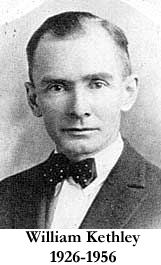 As the youngest college president in the State of Mississippi, William Kethley assumed the reigns of Delta State Teacher’s College in 1926. It was during Kethley’s years as president that the Delta Council was organized on campus and the school became a member of the American Association of Teachers Colleges and the Southern Association of Colleges. President Kethley oversaw widespread campus construction, which took place about every two years after appropriations were granted. His appreciation of nature is still evident today as many of the variety of trees on campus were planted because of his efforts. It was during his tenure in 1955 that Deltat State Teachers College became Delta State College.
As the youngest college president in the State of Mississippi, William Kethley assumed the reigns of Delta State Teacher’s College in 1926. It was during Kethley’s years as president that the Delta Council was organized on campus and the school became a member of the American Association of Teachers Colleges and the Southern Association of Colleges. President Kethley oversaw widespread campus construction, which took place about every two years after appropriations were granted. His appreciation of nature is still evident today as many of the variety of trees on campus were planted because of his efforts. It was during his tenure in 1955 that Deltat State Teachers College became Delta State College.
Dr. James Ewing bolstered the size of the University in every way, from 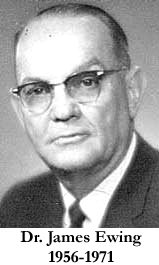 enrollment to buildings to educational divisions. Dr. Ewing increased the student enrollment from 527 to 3,309 by the time he retired. The number of faculty increased by 100 professors and the number of staff holding Ph.D.’s increased by sixfold. After Ewing initiated a massive improvement campaign to increase Delta State’s academic programs, it was decided that the Hill Demonstration School should be discontinued. In 1959, along with all the other campus changes, students adjusted from the quarter system to the semester system. On July1, 1964, Dr. Ewing announced the first full-time alumni secretary, Forest Kent Wyatt. Other academic changes included the addition of a graduate program in the summer of 1965.
enrollment to buildings to educational divisions. Dr. Ewing increased the student enrollment from 527 to 3,309 by the time he retired. The number of faculty increased by 100 professors and the number of staff holding Ph.D.’s increased by sixfold. After Ewing initiated a massive improvement campaign to increase Delta State’s academic programs, it was decided that the Hill Demonstration School should be discontinued. In 1959, along with all the other campus changes, students adjusted from the quarter system to the semester system. On July1, 1964, Dr. Ewing announced the first full-time alumni secretary, Forest Kent Wyatt. Other academic changes included the addition of a graduate program in the summer of 1965.
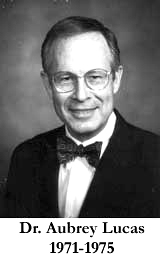 Dr. Lucas worked closely with the National Council of Accreditation for Teacher’s Education and in 1973 Delta State College was reacredited by they Southern Association of Colleges. He also steered the way for a new name in 1974 when Delta State College became Delta State University. “He put in place programs that would make us stronger. He was hiring faculty that was qualified in different fields. He just provided better and stronger academic programs,” reflected President Emeritus Kent Wyatt. In athletics, Dr. Lucas reestablished the women’s basketball program and they rewarded him with a national championship near the end of his reign. Dr. Lucas’ tenure also established two major gifts for the Delta State University Foundation: the Nellie Nugent Somerville Lecture Series on Government and Public Affairs and the West Carillon. Dr. Lucas returned to the University of Southern Mississippi to assume his duties as their new president in 1975. He remained there until 1996.
Dr. Lucas worked closely with the National Council of Accreditation for Teacher’s Education and in 1973 Delta State College was reacredited by they Southern Association of Colleges. He also steered the way for a new name in 1974 when Delta State College became Delta State University. “He put in place programs that would make us stronger. He was hiring faculty that was qualified in different fields. He just provided better and stronger academic programs,” reflected President Emeritus Kent Wyatt. In athletics, Dr. Lucas reestablished the women’s basketball program and they rewarded him with a national championship near the end of his reign. Dr. Lucas’ tenure also established two major gifts for the Delta State University Foundation: the Nellie Nugent Somerville Lecture Series on Government and Public Affairs and the West Carillon. Dr. Lucas returned to the University of Southern Mississippi to assume his duties as their new president in 1975. He remained there until 1996.
Growing up on the Delta State campus, Dr. Wyatt seemed destined to assume a 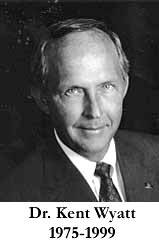 leadership role for the university. Serving under Dr. Ewing as Alumni Director and then as Assistant to the President for both Ewing and Lucas, Wyatt was the first alumnus of the school to be chosen as its leader. It was under Dr. Wyatt’s presidency that the Lady Statesmen forged ahead and won their second and third consecutive national basketball championships. As a member of the Delta community, the English faculty initiated the Delta Area Writing Project to assist Delta schools. Dr. Wyatt became president during the 50th anniversary of Delta State, and would later deliver the first doctoral degree in 1984. Fundraising became an important issue for Delta State when the Alumni Foundation launched its $5 million dollar campaign in 1996. It exceeded that goal in 1999 when it reached the $10 million mark. Dr. Wyatt announced his retirement in 1999 after 24 years of service.
leadership role for the university. Serving under Dr. Ewing as Alumni Director and then as Assistant to the President for both Ewing and Lucas, Wyatt was the first alumnus of the school to be chosen as its leader. It was under Dr. Wyatt’s presidency that the Lady Statesmen forged ahead and won their second and third consecutive national basketball championships. As a member of the Delta community, the English faculty initiated the Delta Area Writing Project to assist Delta schools. Dr. Wyatt became president during the 50th anniversary of Delta State, and would later deliver the first doctoral degree in 1984. Fundraising became an important issue for Delta State when the Alumni Foundation launched its $5 million dollar campaign in 1996. It exceeded that goal in 1999 when it reached the $10 million mark. Dr. Wyatt announced his retirement in 1999 after 24 years of service.
 Dr. Potter arrived from George Mason University where he served as provost. He was named the sixth Delta State president on May 7, 1999. Potter has commented on the “daunting possibilities” he faced to honor the 24 year legacy he assumed. However, he recognized and embraced his responsibility to expand upon the past achievements of Delta State. Dr. Potter took an active and visible role, showing his support at sporting events, art functions, and academic gatherings.
Dr. Potter arrived from George Mason University where he served as provost. He was named the sixth Delta State president on May 7, 1999. Potter has commented on the “daunting possibilities” he faced to honor the 24 year legacy he assumed. However, he recognized and embraced his responsibility to expand upon the past achievements of Delta State. Dr. Potter took an active and visible role, showing his support at sporting events, art functions, and academic gatherings.
With bold ambitions for the schoolâs future, Dr. Hilpert took office as President of Delta State University on 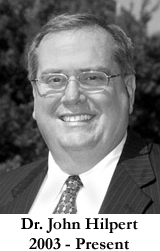 September 1, 2003. Coming off of a very successful tenure as President of Northern State University in Aberdeen, South Dakota, Dr. Hilpert saw great promise not only in Delta State, but in the Delta as a region. With this in mind, he set as the agenda for the University the goal of becoming âthe best regional university in America. Under the leadership of Dr. Hilpert, Delta State has seen an expansion of its facilities, academic opportunities, and dreams for itself.
September 1, 2003. Coming off of a very successful tenure as President of Northern State University in Aberdeen, South Dakota, Dr. Hilpert saw great promise not only in Delta State, but in the Delta as a region. With this in mind, he set as the agenda for the University the goal of becoming âthe best regional university in America. Under the leadership of Dr. Hilpert, Delta State has seen an expansion of its facilities, academic opportunities, and dreams for itself.